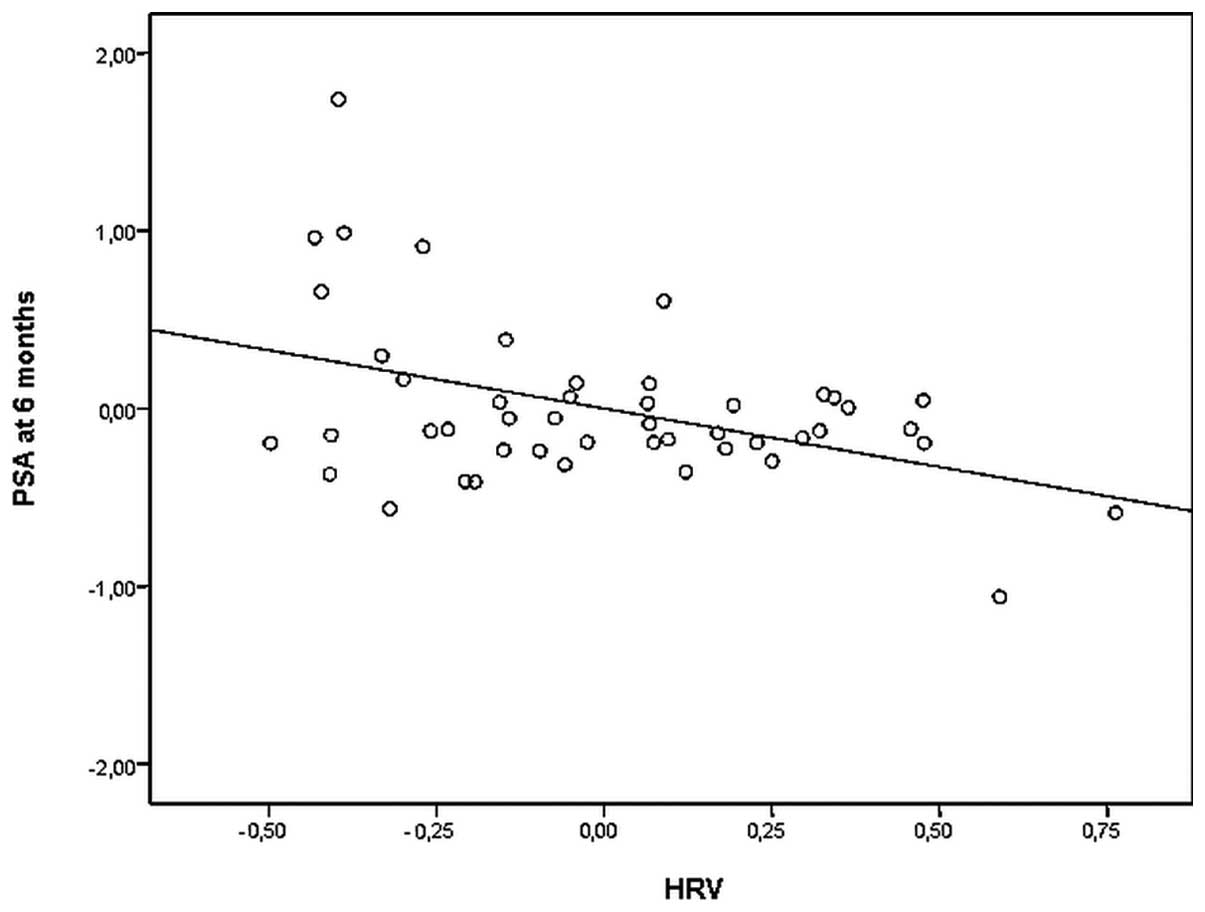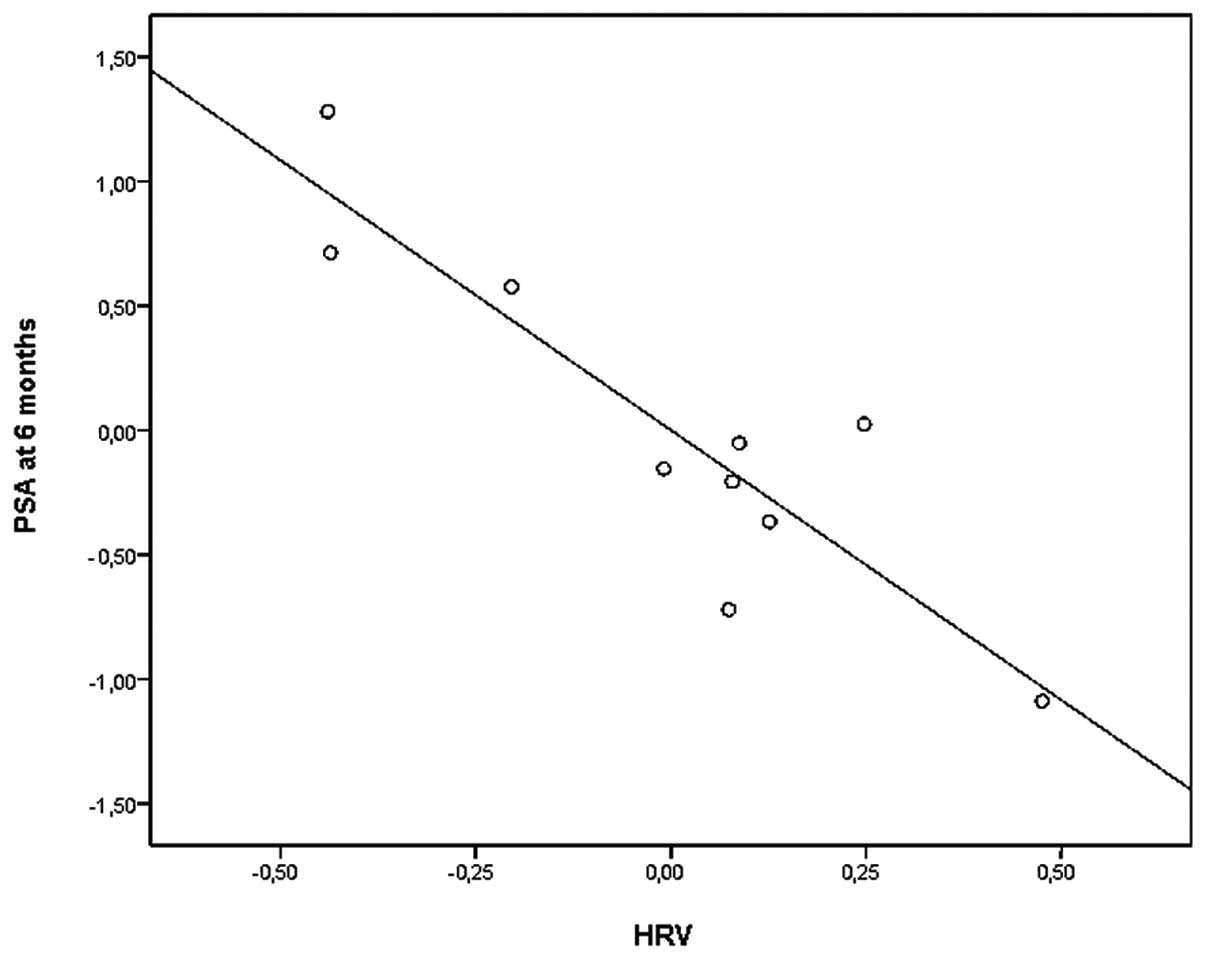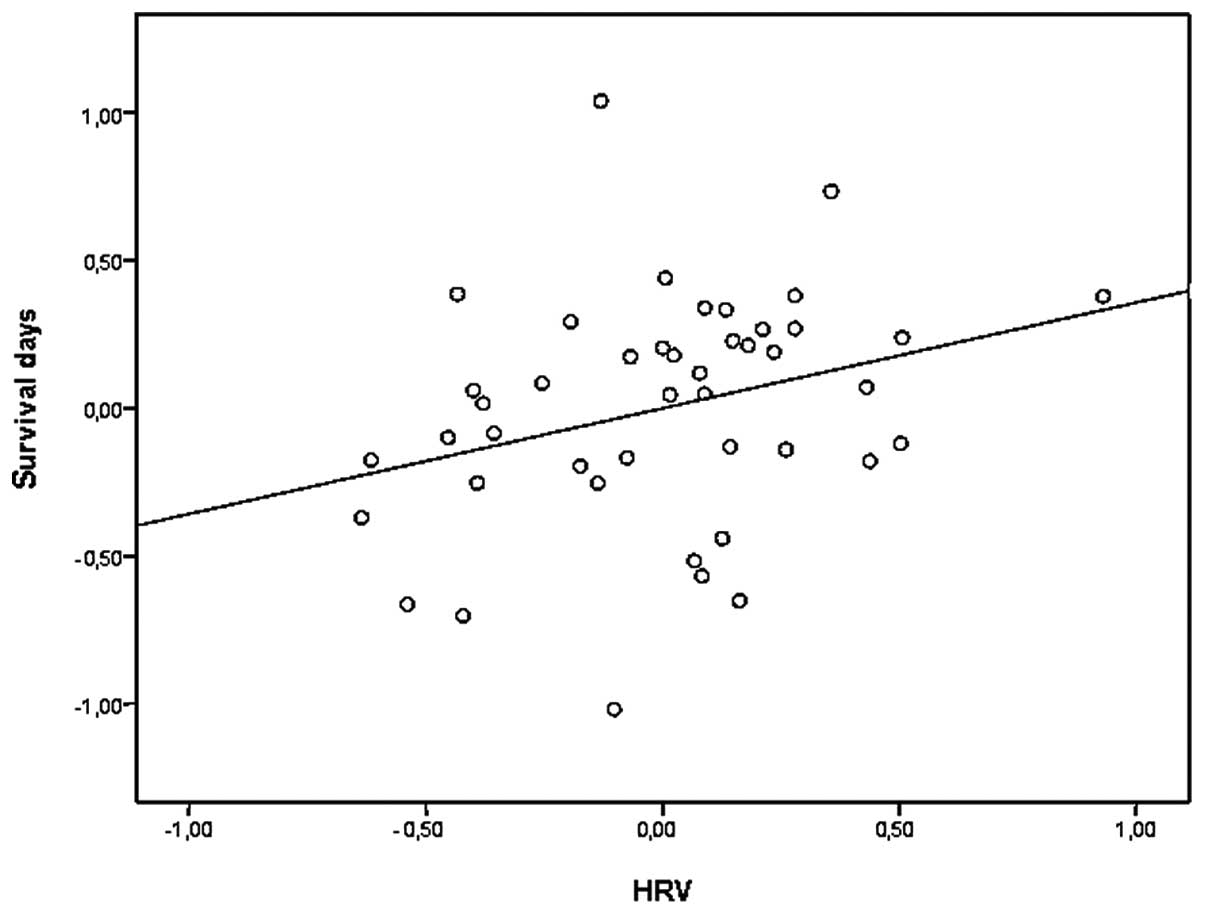|
1
|
Global cancer statistics. CA Cancer J
Clin. 61:69–90. 2011. View Article : Google Scholar
|
|
2
|
Eastham JA: Prostate-specific antigen
doubling time as a prognostic marker in prostate cancer. Nat Clin
Pract Urol. 2:482–491. 2005. View Article : Google Scholar : PubMed/NCBI
|
|
3
|
de Bono JS, Logothetis CJ, Molina A,
Fizazi K, North S, Chu L, Chi KN, Jones RJ, Goodman OB Jr, Saad F,
Staffurth JN, Mainwaring P, Harland S, Flaig TW, Hutson TE, Cheng
T, Patterson H, Hainsworth JD, Ryan CJ, Sternberg CN, Ellard SL,
Fléchon A, Saleh M, Scholz M, Efstathiou E, Zivi A, Bianchini D,
Loriot Y, Chieffo N, Kheoh T, Haqq CM and Scher HI; COU-AA-301
Investigators. Abiraterone and increased survival in metastatic
prostate cancer. N Engl J Med. 364:1995–2005. 2011.
|
|
4
|
Kelsey CR, Marks LB, Hollis D, Hubbs JL,
Ready NE, D’Amico TA and Boyd JA: Local recurrence after surgery
for early stage lung cancer: an 11-year experience with 975
patients. Cancer. 115:5218–5227. 2009.PubMed/NCBI
|
|
5
|
Rosell R, Molina MA, Costa C, Simonetti S,
Gimenez-Capitan A, Bertran-Alamillo J, Mayo C, Moran T, Mendez P,
Cardenal F, Isla D, Provencio M, Cobo M, Insa A, Garcia-Campelo R,
Reguart N, Majem M, Viteri S, Carcereny E, Porta R, Massuti B,
Queralt C, de Aguirre I, Sanchez JM, Sanchez-Ronco M, Mate JL,
Ariza A, Benlloch S, Sanchez JJ, Bivona TG, Sawyers CL and Taron M:
Pretreatment EGFR T790M mutation and BRCA1 mRNA expression in
erlotinib-treated advanced non-small-cell lung cancer patients with
EGFR mutations. Clin Cancer Res. 17:1160–1168. 2011. View Article : Google Scholar
|
|
6
|
Gandhi L and Janne PA: Crizotinib for
ALK-rearranged non-small cell lung cancer: a new targeted therapy
for a new target. Clin Cancer Res. 18:3737–3742. 2012. View Article : Google Scholar : PubMed/NCBI
|
|
7
|
Brundage MD, Davies D and Mackillop WJ:
Prognostic factors in non-small cell lung cancer: a decade of
progress. Chest. 122:1037–1057. 2002. View Article : Google Scholar : PubMed/NCBI
|
|
8
|
Marijon H, Bouyon A, Vignot S and Besse B:
Prognostic and predictive factors in lung cancer. Bull Cancer.
96:391–404. 2009.PubMed/NCBI
|
|
9
|
Lee JH, Song EM, Sim YS, Ryu YJ and Chang
JH: Forced expiratory volume in one second as a prognostic factor
in advanced non-small cell lung cancer. J Thorac Oncol. 6:305–309.
2011.PubMed/NCBI
|
|
10
|
Valko M, Izakovic M, Mazur M, Rhodes CJ
and Telser J: Role of oxygen radicals in DNA damage and cancer
incidence. Mol Cell Biochem. 266:37–56. 2004. View Article : Google Scholar : PubMed/NCBI
|
|
11
|
Faux SP, Tai T, Thorne D, Xu Y, Breheny D
and Gaca M: The role of oxidative stress in the biological
responses of lung epithelial cells to cigarette smoke. Biomarkers.
14:90–96. 2009. View Article : Google Scholar : PubMed/NCBI
|
|
12
|
Maki A, Kono H, Gupta M, Asakawa M, Suzuki
T, Matsuda M, Fujii H and Rusyn I: Predictive power of biomarkers
of oxidative stress and inflammation in patients with hepatitis C
virus-associated hepatocellular carcinoma. Ann Surg Oncol.
14:1182–1190. 2007. View Article : Google Scholar : PubMed/NCBI
|
|
13
|
Pikarsky E, Porat RM, Stein I, Abramovitch
R, Amit S, Kasem S, Gutkovich-Pyest E, Urieli-Shoval S, Galun E and
Ben-Neriah Y: NF-kappaB functions as a tumour promoter in
inflammation-associated cancer. Nature. 431:461–466. 2004.
View Article : Google Scholar : PubMed/NCBI
|
|
14
|
Voronov E, Shouval DS, Krelin Y, et al:
IL-1 is required for tumor invasiveness and angiogenesis. Proc Natl
Acad Sci USA. 100:2645–2650. 2003. View Article : Google Scholar : PubMed/NCBI
|
|
15
|
Mantovani A, Allavena P, Sica A and
Balkwill F: Cancer-related inflammation. Nature. 454:436–444. 2008.
View Article : Google Scholar
|
|
16
|
Entschladen F, Drell TL IV, Lang K, Joseph
J and Zaenker KS: Tumour-cell migration, invasion, and metastasis:
navigation by neurotransmitters. Lancet Oncol. 5:254–258. 2004.
View Article : Google Scholar : PubMed/NCBI
|
|
17
|
Tracey KJ: Reflex control of immunity. Nat
Rev Immunol. 9:418–428. 2009. View
Article : Google Scholar : PubMed/NCBI
|
|
18
|
Ek M, Kurosawa M, Lundeberg T and Ericsson
A: Activation of vagal afferents after intravenous injection of
interleukin-1beta: role of endogenous prostaglandins. J Neurosci.
18:9471–9479. 1998.PubMed/NCBI
|
|
19
|
Pavithran P, Nandeesha H, Sathiyapriya V,
Bobby Z and Madanmohan T: Short-term heart variability and
oxidative stress in newly diagnosed essential hypertension. Clin
Exp Hypertens. 30:486–496. 2009. View Article : Google Scholar : PubMed/NCBI
|
|
20
|
Vlcek M, Radikova Z, Penesova A, et al:
Heart rate variability and catecholamines during hypoglycemia and
orthostasis. Auton Neurosci. 143:53–57. 2008. View Article : Google Scholar : PubMed/NCBI
|
|
21
|
De Couck M, Mravec B and Gidron Y: You may
need the vagus nerve to understand pathophysiology and to treat
diseases. Clin Sci. 122:323–328. 2012.PubMed/NCBI
|
|
22
|
Gidron Y, Perry H and Glennie M: Does the
vagus nerve inform the brain about preclinical tumours and modulate
them? Lancet Oncol. 6:245–248. 2005. View Article : Google Scholar : PubMed/NCBI
|
|
23
|
Task Force of the European Society of
Cardiology and the North American Society of Pacing and
Electrophysiology. Heart rate variability: standards of
measurement, physiological interpretation and clinical use.
Circulation. 93:1043–1065. 1996. View Article : Google Scholar : PubMed/NCBI
|
|
24
|
Kuo TB, Lai CJ, Huang YT and Yang CC:
Regression analysis between heart rate variability and
baroreflex-related vagus nerve activity in rats. J Cardiovasc
Electrophysiol. 16:864–869. 2005. View Article : Google Scholar : PubMed/NCBI
|
|
25
|
Hoffmann J, Grimm W, Menz V, Wied M,
Sprenger A, Arnold R and Maisch B: Prognostic value of heart rate
variability analysis in patients with carcinoid syndrome.
Digestion. 63:35–42. 2001. View Article : Google Scholar : PubMed/NCBI
|
|
26
|
Fadul N, Strasser F, Palmer LJ, Yusuf SW,
Guo Y, Li Z, Allo J and Bruera E: The association between autonomic
dysfunction and survival in male patients with advanced cancer: a
preliminary report. J Pain Symptom Manage. 39:283–290. 2010.
View Article : Google Scholar : PubMed/NCBI
|
|
27
|
Chiang JK, Koo M, Kuo TB and Fu CH:
Association between cardiovascular autonomic functions and time to
death in patients with terminal hepatocellular carcinoma. J Pain
Symptom Manage. 39:673–679. 2010. View Article : Google Scholar
|
|
28
|
Kim do H, Kim JA, Choi YS, Kim SH, Lee JY
and Kim YE: Heart rate variability and length of survival in
hospice cancer patients. J Korean Med Sci. 25:1140–1145.
2010.PubMed/NCBI
|
|
29
|
Mouton C, Ronson A, Razavi D, Delhaye F,
Kupper N, Paesmans M, Moreau M, Nogaret JM, Hendlisz A and Gidron
Y: The relationship between heart rate variability and time-course
of carcinoembryonic antigen in colorectal cancer. Auton Neurosci.
166:96–99. 2012. View Article : Google Scholar : PubMed/NCBI
|
|
30
|
Crimmins EM, Johnston M, Hayward M and
Seeman T: Age differences in allostatic load: an index of
physiological dysregulation. Exp Gerontol. 38:731–734. 2003.
View Article : Google Scholar : PubMed/NCBI
|
|
31
|
Pfleger CC, Flachs EM and Koch-Henriksen
N: Social consequences of multiple sclerosis: clinical and
demographic predictors - a historical prospective cohort study. Eur
J Neurol. 17:1346–1351. 2010.PubMed/NCBI
|
|
32
|
Lerner-Geva L, Keinan-Boker L, Blumstein
T, Boyko V, Olmar L, Mashiach S, Rabinovici J, Potashnik G,
Lunenfeld E, Schenker JG, Shushan A, Fishman A, Cohen I, Vagman I
and Lunenfeld B: Infertility, ovulation induction treatments and
the incidence of breast cancer - a historical prospective cohort of
Israeli women. Breast Cancer Res Treat. 100:201–212. 2006.
View Article : Google Scholar : PubMed/NCBI
|
|
33
|
Thong T, Li K, McNames J, Aboy M and
Goldstein B: Accuracy of ultra-short heart rate variability
measures. Engineering in Medicine and Biology Society. Proc 25th
Annual Int Conference of the IEEE. 3:2424–2427. 2003.
|
|
34
|
Nussinovitch U, Elishkevitz KP, Katz K,
Nussinovitch M, Segev S, Volovitz B and Nussinovitch N: Reliability
of ultra-short ECG indices for heart rate variability. Ann
Noninvasive Electrocardiol. 16:117–122. 2011. View Article : Google Scholar : PubMed/NCBI
|
|
35
|
Hodgart E and Macfarlane PW: 10 second
heart rate variability. Comp Cardiol. 31:217–220. 2004.
|
|
36
|
Schipke JD, Pelzer M and Arnold G: Effect
of respiration rate on short-term heart rate variability. J Clin
Basic Cardiol. 2:92–94. 1999.
|
|
37
|
Poyhonen M, Syvaoja S, Hartikainen J,
Ruokonen E and Takala J: The effect of carbon dioxide, respiratory
rate and tidal volume on human heart rate variability. Acta
Anaesthesiol Scand. 48:93–101. 2004.PubMed/NCBI
|
|
38
|
Strauss-Blasche G, Moser M, Voica M,
McLeod DR, Klammer N and Marktl W: Relative timing of inspiration
and expiration affects respiratory sinus arrhythmia. Clin Exp
Pharmacol Physiol. 27:601–606. 2000. View Article : Google Scholar : PubMed/NCBI
|
|
39
|
Brown JK, Cooley ME, Chernecky C and Sarna
L: A symptom cluster and sentinel symptom experienced by women with
lung cancer. Oncol Nurs Forum. 38:E425–E435. 2011. View Article : Google Scholar : PubMed/NCBI
|
|
40
|
Johannessen A, Lehmann S, Omenaas ER, Eide
GE, Bakke PS and Gulsvik A: Post-bronchodilator spirometry
reference values in adults and implications for disease management.
Am J Respir Crit Care Med. 173:1316–1325. 2006. View Article : Google Scholar : PubMed/NCBI
|
|
41
|
Katona PG and Jih F: Respiratory sinus
arrhythmia: noninvasive measure of parasympathetic cardiac control.
J Appl Physiol. 39:801–805. 1975.PubMed/NCBI
|
|
42
|
Cassart M, Pettiaux N, Gavenois PA, Pavia
M and Estenne M: Effect of chronic hyperinflation on diaphragm
length and surface area. Am J Respir Crit Care Med. 156:504–508.
1997. View Article : Google Scholar : PubMed/NCBI
|
|
43
|
Alifano M, Falcoz PE, Seegers V, Roche N,
Schussler O, Younes M, Antonacci F, Forgez P, Dechartres A, Massard
G, Damotte D and Régnard JF: Preresection serum C-reactive protein
measurement and survival among patients with resectable non-small
cell lung cancer. J Thorac Cardiovasc Surg. 142:1161–1167. 2011.
View Article : Google Scholar : PubMed/NCBI
|
|
44
|
Hamilton RM, McKechnie PS and Macfarlane
PW: Can cardiac vagal tone be estimated from the 10-second ECG? Int
J Cardiol. 95:109–115. 2004. View Article : Google Scholar : PubMed/NCBI
|
|
45
|
Dekker JM, Schouten EG, Klootwijk P, Pool
J, Swenne CA and Kromhout D: Heart rate variability from short
electrocardiographic recordings predicts mortality from all causes
in middle-aged and elderly men. The Zutphen Study. Am J Epidemiol.
145:899–908. 1997. View Article : Google Scholar : PubMed/NCBI
|
|
46
|
O’Donnell K, Brydon L, Wright CE and
Steptoe A: Self-esteem levels and cardiovascular and inflammatory
responses to acute stress. Brain Behav Immun. 22:1241–1247.
2008.PubMed/NCBI
|
|
47
|
Erin N, Akdas Barkan G, Harms JF and
Clawson GA: Vagotomy enhances experimental metastases of 4THMpc
breast cancer cells and alters substance P level. Regul Pept.
151:35–42. 2008. View Article : Google Scholar : PubMed/NCBI
|
|
48
|
Erin N, Boyer PJ, Bonneau RH, Clawson GA
and Welch DR: Capsaicin-mediated denervation of sensory neurons
promotes mammary tumor metastasis to lung and heart. Anticancer
Res. 24:1003–1009. 2004.PubMed/NCBI
|
|
49
|
Erin N, Duymuş O, Oztürk S and Demir N:
Activation of vagus nerve by semapimod alters substance P levels
and decreases breast cancer metastasis. Regul Pept. 179:101–108.
2012. View Article : Google Scholar : PubMed/NCBI
|

















